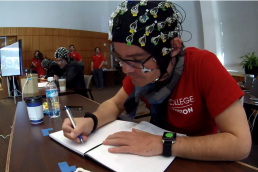
Exquisite Corpse – Creative Writing
We used Mobile brain-body imaging (MoBI) technology to study the human improvisational creative process in the spirit of the “Exquisite Corpse”, an improvisational creative game created by the surrealists in the 1920s, three artists create a three-part art piece. The artists were equipped with 64 channel wireless EEG (2 channel EOG) and 3 inertial measurement units on forearms and head.
In this study, artists wore skullcaps fitted with EEG electrodes and inertial sensors as they played Exquisite Corpse in the context of creative writing. The performance-study seeks to uncover clues to what happens in the brain as people engage in creative writing. The EEG and kinematic data were recorded from the writers while they were involved with the writing. In the context of the Exquisite Corpse, all 3 writers created a collaborative creative literary work. Their brain activity is projected onto a nearby screen as audience members watch and also contribute their MoBI data.
The experiments are conducted in public venues and they provide a platform for interaction between the artists, researchers, and audience. At the end of every experiment (and during the experiment), a question and answer session takes place in which the audience inquires about the technology, performance, or the collaboration itself.
Acknowledgements
NSF award #BCS1533691
Cullen College of Engineering, University of Houston

